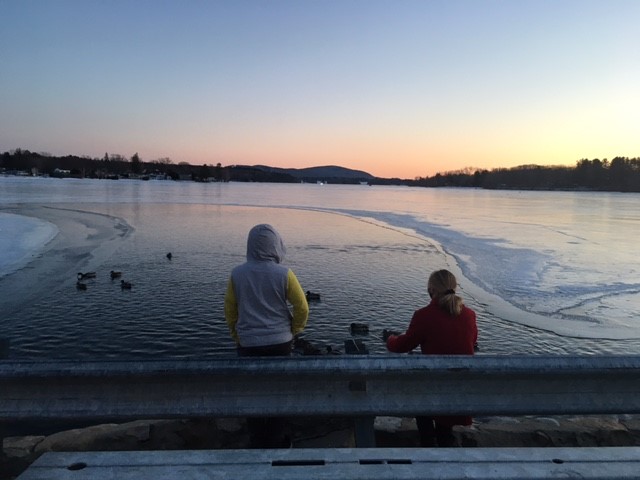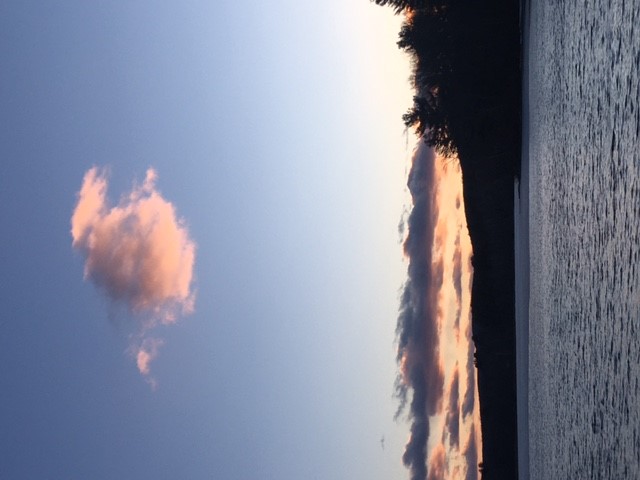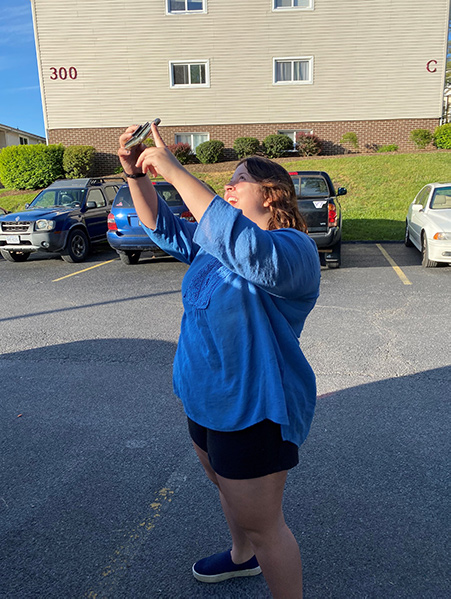News - GLOBE Observer
NASA Interns Help to Solve the Terminator Problem Via GLOBE Challenge

Lindsay Montgomery, GLOBE Solar Terminator Challenge participant, relished the unique opportunity this program provided her and her children. Credits: Courtesy of Lindsay Montgomery
Taking pictures of the clouds above is a popular pastime for photographers of all stripes. NASA Spring 2021 interns were invited to do it for science by participating in a data challenge to help solve the terminator problem.
What is the terminator problem? The solar terminator (or “twilight zone”) is the line that separates the daylit side of a planet from the dark night side. From Earth’s surface we can often see lovely sunrises and sunsets at the terminator. However, these same conditions pose some difficulties for cloud-observing satellites. In particular, the low-light conditions affect the satellite measurements in a way that makes them less sensitive to clouds at low altitudes near the ground, which complicates the algorithms used to detect clouds from satellite observations. Hence the terminator “problem.”
The NASA GLOBE Clouds team at NASA’s Langley Research Center in Hampton, Virginia is working with NASA scientist Dr. Bill Smith who will mentor a summer intern. Together, they will use the GLOBE Cloud observations made by agency interns and citizen scientists to solve the terminator problem.
“A challenging objective for our team is to be able to derive cloud properties that are accurate and consistent at all times of day, which to some degree requires developing new and innovative methods that can improve upon our traditional approaches,” Smith said. He and his team have been exploring the use of machine learning methods to address this problem and others.

“Participating in the GLOBE Solar Terminator Challenge was an incredible experience,” GLOBE Solar Terminator Challenge participant Lindsay Montgomery said. Credits: Courtesy of Lindsay Montgomery
“These new cloud analyses need to be validated to help quantify the level of improvement we are getting,” said Dr. Cecilia Wang, a senior scientist at Science Systems and Applications, Inc. (SSAI) who works closely with Smith on the Satellite ClOud and Radiation Property retrieval System (SatCORPS) cloud analyses.
GLOBE, or Global Learning and Observations to Benefit the Environment, is sponsored by NASA and is a worldwide program that brings together students, teachers, scientists and citizens to promote science and learning about the environment. When citizen scientists submit a GLOBE observation of clouds, the Langley team, with the support of Smith’s SatCORPS products, create a “satellite match” where you can see your observation compared to satellite measurements.
Interns were able to upload photos via the GLOBE Observer app, as well as provide reports about cloud and sky conditions. Together these provide a wealth of information about the terminator problem that is difficult to gather through means other than citizen science participants.

Rose Rizzi, a GLOBE Solar Terminator Challenge contributor, takes a photo of the sky for the program. Credits: Courtesy of Angela Rizzi
“Citizen scientists love to contribute data and get even more energized when they know exactly how their data will be used,” said GLOBE Clouds principal investigator Jessica Taylor. “This is what makes the Solar Terminator Challenge so exciting. Having clouds observations during sunrise and sunset can help us better understand our satellite data.”
The four lead contributors were Lindsay McCarthy from NASA’s Johnson Space center, Rose Rizzi of Langley, Angela Cheng of NASA’s Goddard Space Flight Center and Nakeshia Diop at NASA headquarters. Their consistent observations will be used by a summer intern to work on algorithms for the terminator problem.
McCarthy, who interned remotely from Massachusetts, relished the unique opportunity this program provided her and her children.
“Participating in the GLOBE Solar Terminator Challenge was an incredible experience,” she said. “The Spring 2021 intern challenge provided a beautiful bridge for my three elementary-aged children to participate as well. Daily data collection, that started with ice and snow and ended in sunshine and blooms, was a gift that engaged my family in beautiful and deeply impactful ways.”
Families who would like to get involved can use the GLOBE Clouds Family Guide to learn more about clouds. There are many options to connect with cloud content and learn, observe, engage and create, all while having fun.
“Participating in this challenge was a fun way to dip my toes into citizen science while interning at NASA,” Rizzi said. “As an intern, it was nice to know that my efforts were going to help a future intern analyze the data to further the knowledge of Earth science.”
McCarthy said it was nothing short of joyous to have the occasion to look to the sky each morning and night.”
“Learning about citizen science and making actual contributions together showed us all how we can collectively serve our world scientifically and wholeheartedly,” she said.
Anyone who wants to dip their toes into citizen science can start with the GLOBE Observer app. To contribute to solving the terminator problem, follow the steps outlined in the GLOBE blog.
Eric Gillard
NASA Langley Research Center
Reproduced from this original post
Comments
View more GLOBE Observer news here.








